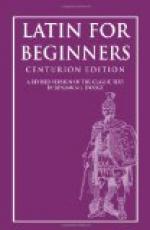[Footnote 3: Observe that in do:, dare\, the a\ is short, and that the present stem is da- and not da:-. The only forms of do:\ that have a long are da:s\ (pres. indic.), da:\ (pres. imv.), and da:ns\ (pres. part.).]
130. The Translation of the Present. In English there are three ways of expressing present action. We may say, for example, I live, I am living, or I do live. In Latin the one expression habito\ covers all three of these expressions.
131. EXERCISES
Give the voice, mood, tense, person, and number of each form.
I. 1. Vocamus, properatis, iubent. 2. Movetis, laudas, vides. 3. Deletis, habetis, dant. 4. Maturas, desiderat, videmus. 5. Iubet, movent, necat. 6. Narramus, moves, vident. 7. Laboratis, properant, portas, parant. 8. Delet, habetis, iubemus, das.
N.B. Observe that the personal ending is of prime importance in translating a Latin verb form. Give that your first attention.
II. 1. We plow, we are plowing, we do plow. 2. They care for, they are caring for, they do care for. 3. You give, you are having, you do have (sing.). 4. We destroy, I do long for, they are living. 5. He calls, they see, we are telling. 6. We do fight, we order, he is moving, he prepares. 7. They are laboring, we kill, you announce.
LESSON XX
IMPERFECT ACTIVE INDICATIVE OF AMO: AND MONEO:
[Special Vocabulary]
NOUNS
fo:rma, -ae\, f., _form, beauty_
regi:na, -ae\, f., queen (regal)
poena, -ae\, f., _punishment, penalty_
superbia, -ae, f., _pride, haughtiness_
potentia, -ae\, f., power (potent)
tri:sti:ti:a, -ae\, f., _sadness, sorrow_
ADJECTIVES
septem\, indeclinable, _seven_
superbus, -a, -um\, proud, haughty
(superb)
CONJUNCTIONS
no:n so:lum ... sed etiam\, _not only
... but also_
132. Tense Signs. Instead of using auxiliary verbs to express differences in tense, like was, shall, will, etc., Latin adds to the verb stem certain elements that have the force of auxiliary verbs. These are called tense signs.
133. Formation and Inflection of the Imperfect. The tense sign of the imperfect is -ba:-, which is added to the present stem. The imperfect consists, therefore, of three parts:
PRESENT STEM TENSE SIGN PERSONAL ENDING ama:- ba- m loving was I
The inflection is as follows:
CONJUGATION I CONJUGATION
II
PERSONAL
SINGULAR
ENDINGS
1. ama:’bam, I was loving mone:’bam,
I was advising -m 2. ama:’ba:s,
you were loving mone:’ba:s, you were
advising -s 3. ama:’bat, he was loving
mone:’bat, he was advising -t




